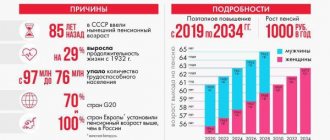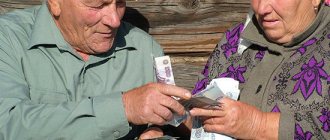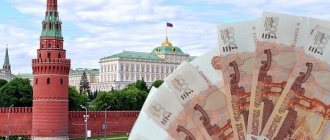Types of pensions in Russia
In the Russian Federation, there are several types of pensions, which are divided according to the conditions of assignment. According to Federal Law No. 166 of December 15, 2001, the pension can be:
- Old-age insurance (otherwise called labor insurance) - to receive it, you must reach retirement age, have at least the minimum insurance period and the required number of points.
- Social - payments of this type are assigned in the event of the loss of a breadwinner, disabled people or persons who have lived to old age but do not have the necessary length of service.
- State - such provision is intended to compensate for lost income for certain categories of citizens (for example, victims of radiation, military pensioners or test pilots). This type of accrual depends on a number of conditions - the absence of another form of income, the presence of work experience, etc.
The difference between a social old-age pension and an insurance pension
In 2018, not much is required to receive an old-age insurance pension in Russia. Those who reached retirement age this year (women born in 1963 and men born in 1958) must also have:
- minimum 9 years of insurance experience,
- minimum 13.8 pension points.
In addition to work experience, the insurance period also includes some other periods of a person’s life, including military service, being on maternity leave, etc.
A social old-age pension is received by those who have not reached the above minimum by a certain age in terms of length of service and the number of pension points earned.
It is worth keeping in mind that the retirement age for those receiving a social pension is five years higher than for everyone else. In 2018 this is:
- 60 years - for women,
- 65 years old - for men.
Since the citizen, by the time he reaches the generally accepted retirement age, has not contributed enough funds to the budget of the country's Pension Fund, the state agrees to begin paying him a pension only after five years. During this time, a person also has the opportunity to earn the required minimum length of service and pension points. If the minimum is reached within these five years, the citizen will have a basis for receiving an insurance pension.
Another nuance that you need to know about is that since the beginning of 2015, the rules for assigning social old-age pensions in Russia have changed slightly. Now foreign citizens and stateless persons can receive Russian social pensions only if they prove that they have lived in Russia for at least 15 years.
How is the old age pension calculated?
In accordance with pension legislation (and this is the federal law of December 28, 2013 No. 400-FZ “On Insurance Pensions”), which came into force on January 1, 2015, the procedure for calculating social benefits in old age implies the fulfillment of several conditions. These are conditions such as:
- Reaching retirement age (55 and 60 years for women/men).
- Required experience. This figure increases annually, and for 2018 it is 9 years.
- Availability of the required amount of pension points. For 2021, this number is 13.8 points.
Those who want to apply for an old-age pension in 2021 must take into account that when calculating the insurance period, only the time of official employment is taken into account (that is, when the employer made transfers to the pension fund). Unofficial work or freelancing without a record of employment does not in any way affect the length of service, so those who seek to receive social benefits from the state upon retirement must get an official job.
As it was before
A person can receive a pension benefit for several reasons - old age, length of service, or due to incapacity for work. Let's talk about old-age pensions. They come in these types:
- An insurance pension is assigned to the vast majority of citizens of the Russian Federation who were included in the compulsory insurance system (SNILS). To receive this pension, a Russian needs to work for a certain time and earn a minimum of pension points.
- The state pension is awarded to persons who suffered as a result of man-made or radiation disasters.
- The social pension is assigned to those people who are not entitled to insurance or state pensions.
A person can receive a social pension only five years later in comparison with an insurance pension, and this type of pension cannot be combined with official work. That is, a pensioner must choose either a pension or a job.
According to statistics, in most cases it is insurance pensions that are prescribed. And the pension reform affects them. According to current legislation, old-age pensions are available to men over 60 years of age and women over 55 years of age. If they have at least nine years of work experience as of the current year, every 12 months this figure increases by a year to 15 years. And also if the sum of pension points in 2021 is 13.8.
From June 1, 2021, the passbook is now illegal
The pension reform changed the retirement age. Thus, men will be able to retire only after 65 years of age, and women at 63 years of age.
Who is entitled to old age insurance pensions?
The legislation clearly defines the persons who can receive pension payments. These people can be divided into the following categories:
- Citizens of Russia: women at least 55 years old, men – 60 years old, with an established amount of insurance coverage.
- Citizens of Russia who are in the civil service: - from January 1, 2017, an increasing coefficient will be introduced - annually the retirement age for this category will increase by six months (with a “ceiling” of 63 and 65 years for women/men). For this category, the old-age pension in 2018 is intended for women who have reached 56 years of age, and for men - 61 years of age.
- Citizens of Russia who have worked in the northern territories (and equivalent areas) for at least 15 years: women at least 50 years old, men - 55 years old.
- Foreign citizens: women at least 60 years old, men – 65 years old, with Russian work experience of at least 15 years.
To calculate payments, the Pension Fund has special formulas that take into account age, length of service and other indicators. It is important that work experience also includes time spent studying at a higher educational institution or military service. Working in hazardous conditions means early retirement (as a rule, the amount of payments in this case will be larger).
Conditions of receipt
The minimum length of service and the individual pensioner coefficient (IPC) are not constant values - until 2025, they will increase annually. Therefore, the requirements for those retiring in old age will change every year. The table shows this dynamics, according to the Law “On Insurance Pensions”:
| Year | Minimum work experience, years | Minimum IPC, points |
| 2017 | 8 | 11,4 |
| 2018 | 9 | 13,8 |
| 2019 | 10 | 16,2 |
| 2025 | 16 | 30 |
Table of conditions for assigning an old-age insurance pension
Using the table presented, you can calculate the required type of subsidy assignment:
- Year.
- Requirements for insurance experience (years).
- Minimum IPC amount.
- Maximum annual score.
- When forming an insurance pension.
- When forming an insurance and funded pension 2015 6 6.6 7.39 4.62 2021 7 9 7.83 4.89 2021 8 11.4 8.26 5.16 2021 9 13.8 8.70 5.43 2021 10 16.2 9.13 5.71 2021 11 18.6 9.57 5.98 2021 12 21 10 6.25 2022 13 23.4 10 6.25 2023 14 25.8 10 6.25 2024 15 28.2 10 6.25 2025 15 30 10 6.25
How to apply
Making payments involves a certain sequence of actions. It looks like this step by step - you need to:
- Collect the necessary documentation confirming the length of service and benefits provided.
- Prepare an application for the Pension Fund and submit it along with a package of documents.
- If necessary, you must provide the required documentation.
- Find out about the positive decision and start receiving pension payments.
Where to contact
An application for receiving payments is submitted to the local branch of the Pension Fund of Russia (PFR). Another option is to do this through the Multifunctional Center (MFC). In this case, the recipient of payments can:
- contact in person;
- use the services of a legal representative;
- fill out an application electronically on the Pension Fund website;
- send the document by mail;
- do this with the help of your employer.
Russian citizens who have traveled abroad must submit an application directly to the Pension Fund (Moscow, Shabolovka St., 4). In all cases, the date of application will be considered the day when the application was accepted (the letter was sent), and if the document is prepared in electronic form, the time of submission via the Internet. It is necessary to take into account that it is necessary to prepare and submit an application no earlier than a month before the retirement date.
What documents are needed
In addition to the application, it is necessary to submit a number of documents confirming that the applicant is entitled to an old-age pension in 2018. The package of documents must include:
- passport of a Russian citizen (or residence permit for foreigners);
- document on compulsory pension insurance (SNILS);
- work book and other documents confirming work experience and its duration;
- data on average monthly earnings for the last 5 years;
- supporting documents in the presence of additional circumstances (for example, early retirement for workers in the Far North).
Appointment dates
An application submitted to the Pension Fund of Russia is considered within ten working days from the date of submission or mailing, while 3 months are given to prepare the documentation package. If this deadline is not met, the submission time is considered to be the day the last document was submitted. Payments are assigned from the time the application is submitted, but not earlier than the required age. However, if an employee quits his job and prepares an application within 30 days, payments can be assigned earlier than the day of application and the pension is assigned from the next day after completion of work.
Pension payments are made every month. At the same time, the recipient can choose the delivery method convenient for him. In addition to the recipient himself, a pension can be issued to a trusted person - this requires a power of attorney and annual confirmation of the pensioner’s registration at the place of receipt.
Existing methods for delivering pension payments provide the recipient with the opportunity to choose the option that is suitable for him (by notifying the Pension Fund about this via a personal request or by logging into his personal account on the website). These are options such as:
- Using Russian Post - home delivery or collection at the post office. When delivering to your home, a schedule is set and the end date of the delivery period is determined - it will be different for different post offices, so it needs to be clarified in advance. If pension payments are not claimed within six months, they are suspended until the circumstances are clarified.
- Through the bank - directly at the branch or with a transfer to a plastic card. Money is transferred without commission, on the day the funds are received from the Pension Fund, and you can withdraw them from the card at any time. From July 1, 2017, for pension payments, banks issue exclusively plastic cards of the national payment system “Mir”.
- Through an organization engaged in the delivery of pension payments - a complete list of these organizations is on the Pension Fund website. The procedure for receiving it is the same as using Russian Post - at the company’s office or with home delivery.
What is the social old-age pension and who is entitled to it.
Citizens who do not receive any other pension have the right to a social old-age pension. “Other pension” is insurance, military, etc. The old-age social pension is assigned upon reaching the retirement age of 60 years for women and 65 years for men.
Don't assume that when you turn 65 you will be eligible for Social Security. No. If you are already a recipient of an insurance or some other pension, then you are not entitled to a social pension.
Amount of fixed payment to the insurance pension
As of the end of 2021, the fixed pension payment is equal to 4805.11 rubles, which are accrued every month. This amount can be increased if the pensioner is included in the preferential list - then, depending on the category, the amount of the additional payment will be 6246.64-21622.99 rubles. The table shows the categories of citizens who have the right to a monthly fixed payment:
| Category of citizens | Monthly payment amount, rubles | |
| Having no dependents - citizens over 80 years of age or disabled people of the first group | 9610,22 | |
| Citizens of the same category with 1-2-3 dependents | 11211,92-12813,62-14415,32 | |
| Citizens under 80 years of age who do not have a disability of the first group and have 1-2-3 dependents | 6406,81-8008,51-9610,21 | |
| Residents of the Far North (and areas that are equivalent to it) | When using the increasing coefficient, the pension will increase by the specified amount | |
| Citizens, having worked for 15 or more years in the regions of the Far North, and having a work experience for men of 25 years or more, for women 5 years less. | Persons without dependents under 80 years of age and in the absence of disability of the first group | 6246,64 |
| Persons over 80 years of age who have no dependents or have a disability of the first group | 12493,28 | |
| Persons with 1-2-3 dependents under 80 years of age and in the absence of disability of the first group | 8328,85-10411,06-12493,27 | |
| Persons with 1-2-3 dependents over 80 years of age or if there is a disability of the first group | 14575,49-16657,70-18739,91 | |
| Citizens, having worked for 20 or more years in the regions of the Far North, and having a work experience for men of 25 years or more, for women 5 years less. | Persons without dependents under 80 years of age and in the absence of disability of the first group | 7207,67 |
| Persons over 80 years of age who have no dependents or have a disability of the first group | 14415,34 | |
| Persons with 1-2-3 dependents under 80 years of age and in the absence of disability of the first group | 9610,22-12012,77-14415,32 | |
| Persons with 1-2-3 dependents over 80 years of age or if there is a disability of the first group | 16817,89-19220,44-21622,99 | |
- Calculation of transport tax
- Shrimp pasta: recipes
- How to get rid of bad breath quickly
Why is a social old-age pension awarded?
The assignment of a social old-age pension is preceded by a refusal to assign an insurance pension - admittedly, a rather dramatic event in life. This is when, upon reaching the retirement age of 55 years for women and 60 years for men, you apply to the Pension Fund to apply for a pension, but you are denied this.
Until 2015, the only reason for refusal to grant an insurance (labor) pension was a lack of official work experience. Since 2015, another reason for refusal has been added - a lack of so-called pension points.
Requirements for experience and points are growing every year. If in 2017, in order to receive an old-age insurance pension, you had to have at least 8 years of official experience and 11.4 pension points, then in 2021 this bar increased to 9 years of experience and 13.8 pension points. And in 2021 it will rise to 10 years of experience and 16.2 points.
This means that the number of Russians who are denied an insurance pension is growing every year. In this case, they become entitled to a social pension.
The only problem is that the social pension is assigned five years later than the insurance pension. You will have to live another five years without a pension. And only when you turn 60 years old (women) and 65 years old (men), you will be assigned a social pension.
Social supplement to pensions for pensioners in 2021, supplement
Increase in old age pension in 2021
Pensioners belong to the category of socially unprotected disabled citizens (only a few continue to work after retirement), so they are very susceptible to changes in consumer prices. In order for the paid pension to correspond to the level of inflation, the amount of payments is adjusted annually (indexation). As inflation rises, the insurance pension will also increase within the prescribed indexation limits and taking into account the cost of the IPC. Thus, from February 1, 2018, old-age pensions and fixed payments will increase by 5.8%.
Minimum size
The amount of the minimum old-age pension is directly related to the pensioner’s subsistence level (PMP), which is established annually by the Russian Government (for example, for 2021, the PMP is 8,540 rubles). At the same time, different regions may have their own allowances from local budgets, so PFP-2017 for Moscow is 11,561 rubles, for the Moscow region - 9,161 rubles, and for Yakutia - 13,907 rubles.
What to do if your pension is below the subsistence level
In some regions, the minimum old-age pension in 2018 is less than the subsistence level of a pensioner - for example, Ivanovo (RUB 7,977) and Kursk (RUB 7,460) regions can be cited. Looking at the list of pension benefits by region of Russia, the difference in the size of pension accruals is very noticeable, but this does not mean that pensioners in these federal subjects are forced to endure hardships, as it may seem at first.
In a situation where regional payments are lower than the federal PMP, a premium is established for pensioners to compensate for this difference, based on additional laws adopted by regional authorities. The smallest amount that will be paid to a Russian old-age pensioner in 2021 will be equal to 8,540 rubles - in pure form or with increases if necessary.
Calculation of the insurance part of the pension
The formula used in the final calculation of insurance premiums is simple. It consists of three indicators:
RP = IPK x SPK, where:
- RP – final amount of compensation;
- IPC - individual pensioner coefficient;
- SPK is the price of this coefficient at the time of assignment of pension payments.
A pensioner may decide that there are no difficulties, however, the multipliers of the formula - IPC and SPK - depend on several factors, the IPC is calculated individually, being directly dependent on the size of contributions to the individual account, and the number of years worked. The SPK changes every year, depending on the level of inflation and changes in the legislative framework, so a specific calculation is difficult for an unprepared person.
- Oatmeal in a slow cooker - recipes with photos. How to cook oatmeal with milk or water in a slow cooker
- A composting toilet for a summer residence without odor and pumping - how it works. Where to buy and how to choose a dry closet for your dacha with prices
- Steamed fish in a slow cooker
The value of the IPK in 2021
The factor determining the final amount of compensation is the IPC. The calculation of the coefficient is complex; the formula takes into account data on monthly income before and after 2015, allowing citizens to retain their rights under previously adopted laws establishing pension supplements. The general formula looks like this:
IPC = KSP x (IPK₁ + IPC₂), where:
- KSP is an incentive increasing indicator used to calculate pension benefits for people who retire later than the established deadlines. When going on vacation with a year delay, the total IPC increases by 7%, with an eight-year delay - by 90%.
- IPC₁ is an individual coefficient applied until January 1, 2015.
- IPC₂ is an individual indicator used after January 1, 2015.
Fixed payment
As an analogue of the basic benefit, a fixed payment to the insurance pension in 2021 is assigned simultaneously with it. The amount of the surcharge is determined by the state, amounting to 4823 rubles 37 kopecks in 2021. Federal legislation establishes:
- Persons who have reached the age of 80, orphans, people with dependents, as well as those who have lived in the Far North for 15-20 years, and in rural areas for 30 years, may qualify for an increased amount of additional payment.
- For disabled people of group 3 and those applying for benefits for the loss of a breadwinner, 50% of the fixed benefit is established.
- If a person has the right to receive compensation upon reaching age, but refuses it, then it is indexed by an increasing factor.
- The surcharge is subject to annual indexation and may increase as PFR reserves increase.
Will there be indexation for working pensioners?
In 2021, innovative technology will be used for the procedure for indexing pension accruals. Initially, funds for indexation were included in the budget, and the percentage increase obviously had to exceed inflation. This makes it possible to calculate the old-age pension in 2021, without relying on statistical calculations, and to increase pension payments by 3.7 percent from January 1, 2018, and not from February 1, as was the case before. The average pension value in 2017 is 13,557 rubles; from 2021 it will increase to 14,045 rubles. - this means that the average increase will be 488 rubles.
The procedure for calculating and assigning pensions
Currently, the calculation of the amount of pension payments is carried out on the basis of pension points, the number of which depends on the employee’s length of service, the amount of his salary and some other factors.
In 2021, to obtain the right to receive an old-age labor pension, a citizen must have at least 9 pension points and 7 years of experience. The cost of one pension point in 2021 is 74.27 rubles, the maximum possible number of points that a working citizen can receive is 7.83.
The calculation of points on the basis of which the amount of pension payments will be determined when a citizen reaches a certain age is based on the following indicators:
- Wage. The higher it is, the more points a working citizen can “accumulate” in a year;
- Size of work experience. The more experience, the greater the likelihood of gaining the maximum number of points;
- Retirement age. In the event that, having reached retirement age, a citizen does not apply for its accrual to the Pension Fund, but continues to work, forming pension savings, he will be able to earn additional pension points;
- Non-working periods. In contrast to the time during which the citizen was not officially employed and did not receive income from which pension contributions were made, periods when the employee was on annual or maternity leave, parental leave, etc. will earn him extra points.
Retirement table from 2021
The increase in working age will occur smoothly, which means many citizens will begin to receive an old-age insurance pension during the transition period . These include:
- women born 1964-1971;
- men born 1959-1963.
Russians born after this period will retire upon reaching the new established age (63 and 65 years).
Table of increasing the retirement age in Russia for women
| Year of birth | Year of retirement under the new reform | New retirement age, years | How much will the retirement age increase? |
| 1964 | 2020 | 56 | +1 year |
| 1965 | 2022 | 57 | +2 years |
| 1966 | 2024 | 58 | +3 years |
| 1967 | 2026 | 59 | +4 years |
| 1968 | 2028 | 60 | +5 years |
| 1969 | 2030 | 61 | +6 years |
| 1970 | 2032 | 62 | +7 years |
| 1971 | 2034 | 63 | +8 years |
Table of increasing retirement age for men
| Year of birth | Year of retirement under the new reform | New retirement age, years | How much will the retirement age increase? |
| 1959 | 2020 | 61 | +1 year |
| 1960 | 2022 | 62 | +2 years |
| 1961 | 2024 | 63 | +3 years |
| 1962 | 2026 | 64 | +4 years |
| 1963 | 2028 | 65 | +5 years |
Universal right to old age pension
Until 1956, the USSR pension system was extremely confusing and was regulated by dozens of different regulations. In 1956, a unified USSR law “On State Pensions” dated July 14, 1956 was adopted, which established the universal right of citizens to receive an old-age pension.
In accordance with this law, since 1956, the following have had the right to receive a pension:
- men who have reached 60 years of age and have worked for at least 25 years,
- women upon reaching 55 years of age and with at least 20 years of work experience.
Persons who reached retirement age but did not have sufficient work experience were assigned an old-age pension in an amount proportional to their length of service, but not less than 25% of the full pension.
Pensions were calculated from average monthly actual earnings. This earnings included all types of wages, except for wages for overtime work, for part-time work and all kinds of one-time payments. Average monthly earnings for calculating pensions were taken for the last year of work or for any 5 consecutive years of the last 10 years of work.
In cases where the employee’s salary ranged from 80 to 100 rubles per month, the pension was accrued in the amount of 55% of the salary (the minimum pension here is 52 rubles).
If an employee received more than 100 rubles per month, his pension was no more than 50% of monthly earnings, but not less than 55 rubles per month.
At the same time, after retirement, it was allowed to work for some more time in a higher-paying position in order to increase the size of the pension. It was necessary to work for at least 2 years and the pensioner was recalculated in the direction of increasing it.
There were also various pension supplements. For example, for continuous work experience of more than 15 years or for total work experience, men who worked for at least 35 years and women who worked for at least 30 years were entitled to another 10% of the pension.
Pensions with all allowances were assigned within 100% of the earnings from which the pension was calculated, and not in excess of the maximum pension amounts. This restriction did not apply to disabled people of group 1, as well as families that have lost their breadwinners or with three or more disabled people. Also, this restriction did not apply to beneficiaries who were employed in hazardous and hazardous industries.
The minimum old-age pension was 50 rubles per month, and the maximum amount was 120 rubles per month.
Persons who worked in jobs qualifying for benefits for 15 to 20 years were paid a pension in the amount of 140 rubles. If the length of service in such jobs exceeded 20 years, the maximum pension was already 160 rubles per month.
The pension, calculated at an amount not exceeding 60 rubles per month, 10 years after its appointment was increased by 1% of the earnings from which it was calculated for each full year that passed after its appointment. Subsequent increases in the pension, set at no more than 60 rubles, were made every 2 years by 2% of the same earnings.
Payment of pensions was provided by the state from budgetary funds. For this purpose, the state social insurance budget was formed annually. It consisted of state budgetary funds, as well as insurance premiums of enterprises, institutions and organizations. Contributions were paid by enterprises without any deductions from employees' salaries.
The legislative recognition of the right to receive pensions by collective farmers occurred almost 10 years after the adoption of the law on state pensions. In 1965, the USSR Law “On pensions and benefits for members of collective farms” dated July 15, 1964 came into force.
All collective farmers now have the right to receive pensions upon reaching retirement age (60 years for men and 55 for women) and having the required work experience (at least 25 years for men and at least 20 for women).
Initially, pensions for collective farmers were assigned in the amount of 12 rubles per month. But this value could be revised upward by the collective farm management. The pension increased every year. In addition to money, the collective farm board could provide other material assistance to its pensioners. For example, in the form of distribution of crops and food products. By 1987, the minimum amount of collective farm pensions was 40 rubles per month, and pensions paid for at least 10 years were 50 rubles.











